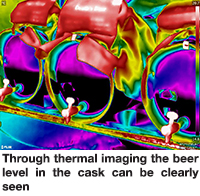See when casks are running empty
03/08/2018
It is summer festival season and, for many, there is nothing better than a pint of real ale to quench the thirst. But when demand is high, it is especially important for the busy bartender to know when the gravity-fed cask is nearing empty. No one wants to serve, or be served, a glassful of sediment, so the traditional prevention methods are to manually record the number of units dispensed from the cask coupled with dipstick testing to double-check the level. This is laborious and time-consuming and certainly not ideal when there are queues of thirsty customers waiting to be served.
No one wants to serve, or be served, a glassful of sediment, so the traditional prevention methods are to manually record the number of units dispensed from the cask coupled with dipstick testing to double-check the level. This is laborious and time-consuming and certainly not ideal when there are queues of thirsty customers waiting to be served.One solution that is proving increasingly popular is thermal imaging. This technology is extensively used throughout industry in all manner of fault-finding applications, as well as for inspecting vessels and monitoring their content level. Until recently, however, the cost of an infrared camera had ruled out its use for niche applications such as commercial beer cask checking.
FLIR Systems has been instrumental in rolling out the technology to a much wider audience with the development of its Lepton® micro-detector, which is the size of a SIM card. This has led to thermal imaging being incorporated into meters for the trades and even smartphones. As a result, it is now a simple, quick and highly cost-effective detection method that recently proved its worth at the Cambridge Beer Festival.
Allister Pirrie, Thermal Imaging Expert and Thermographer with Baldock-based building surveyors Stanburys Ltd, was invited to demonstrate the scope of the technology at the event: “I met one of the organisers at a completely unrelated trade show where I was using thermal imaging to confirm the energy efficiency of a new pipe lagging system,” Allister explained. “A man in the audience then asked if the camera would be able to detect the fluid level in beer casks and I ended up putting the camera through its paces at the festival. The image below shows how clearly the beer level can be seen in the cask and there are a range of FLIR cameras available from Stanburys suitable for the job, including the entry-level FLIR C2 and FLIR C3 fully-featured, pocket-sized thermal imaging cameras.
Another big benefit of thermal imaging is that it is not restricted to a single application. It can also be used to take a temperature measurement of the beer from the face of the cask or the gas cylinder level on a barbeque, for example.
www.flir.com